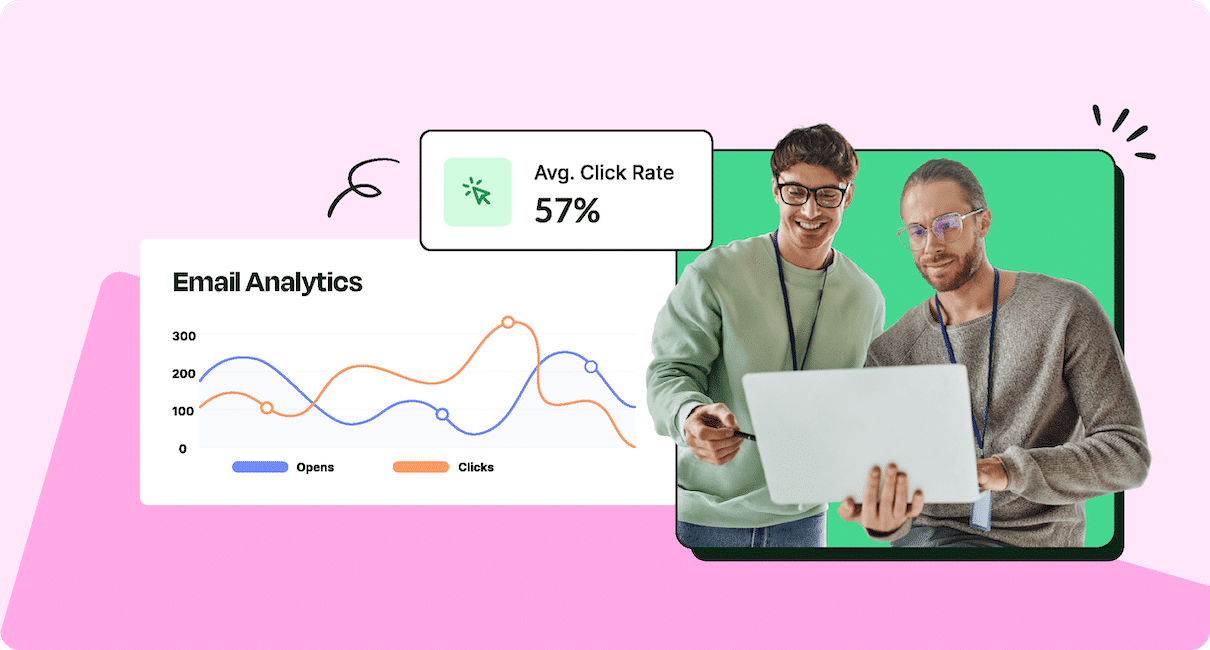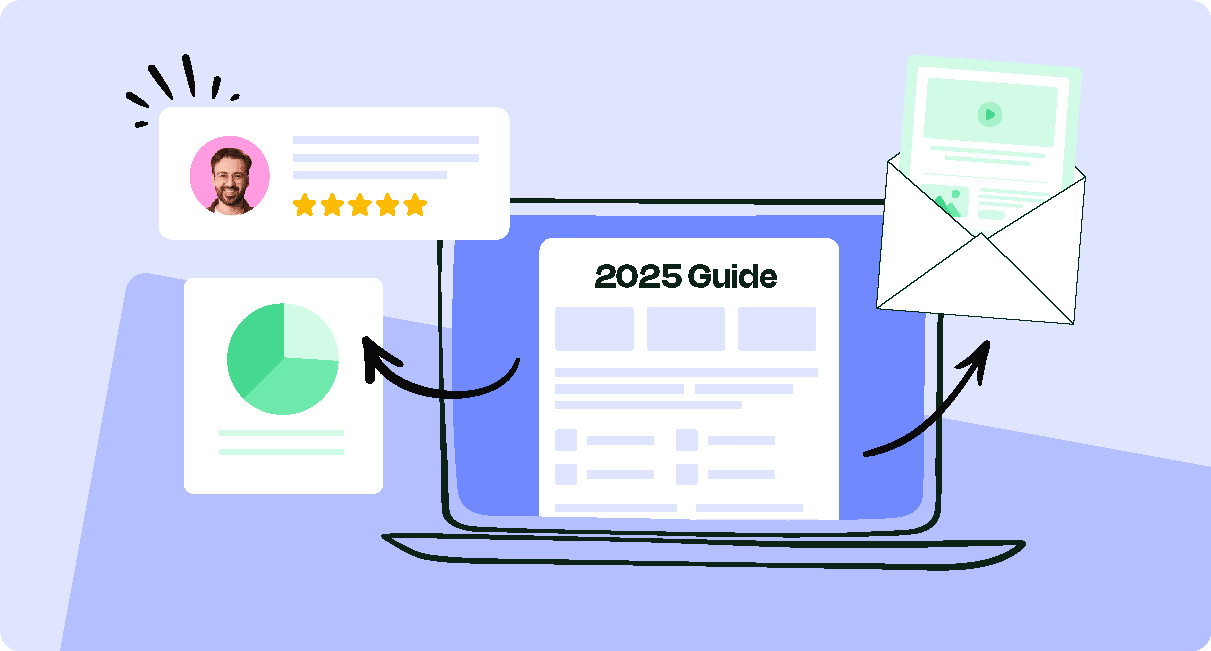We understand the pressure to keep employees engaged—especially when workforces are hybrid, expectations are high, and budgets are tight. The problem-solver? Smarter data. This guide unpacks what you need to know to lead employee engagement at your organization, all driven by analytics.
What is going on with employee engagement? That’s the question keeping a lot of HR leaders and internal comms pros up at night. Because something feels off. Surveys are going out, emails are being sent, and yet…the connection just isn’t there.
Pulse scores are dipping. Turnover is creeping up. And leadership keeps asking for numbers you’re not totally confident in. You’re not alone—across industries, teams are trying to measure engagement but coming up short on clarity.
So we decided to dig in. What does good employee engagement analytics actually look like in 2025? How do you go from vague vibes to actionable data? What tools and strategies are actually worth your time? And can you use engagement analytics to prove the ROI of internal comms? Read on to find out.
Take a self-guided tour of ContactMonkey
See how our key features can streamline your internal communications.
Take product tour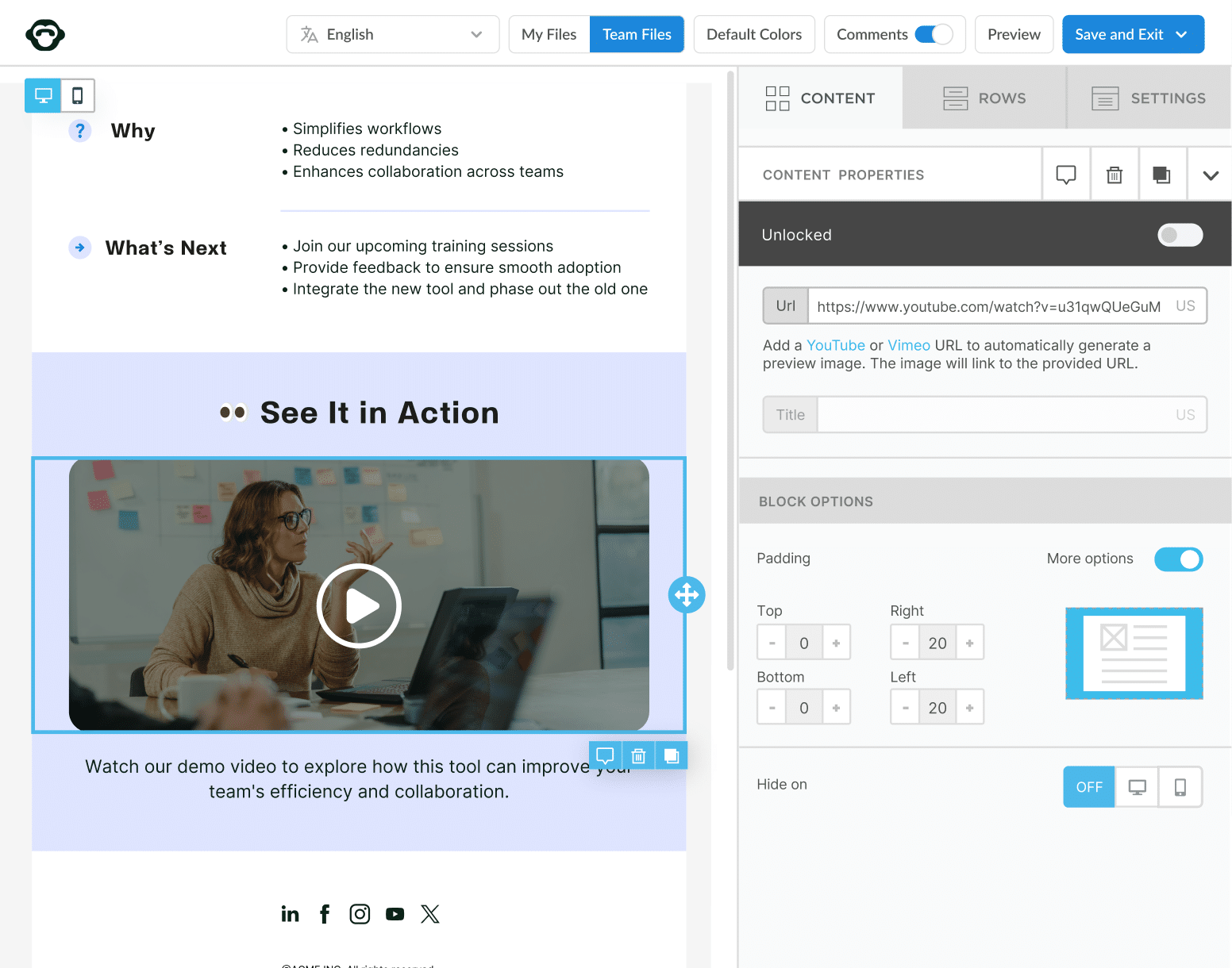
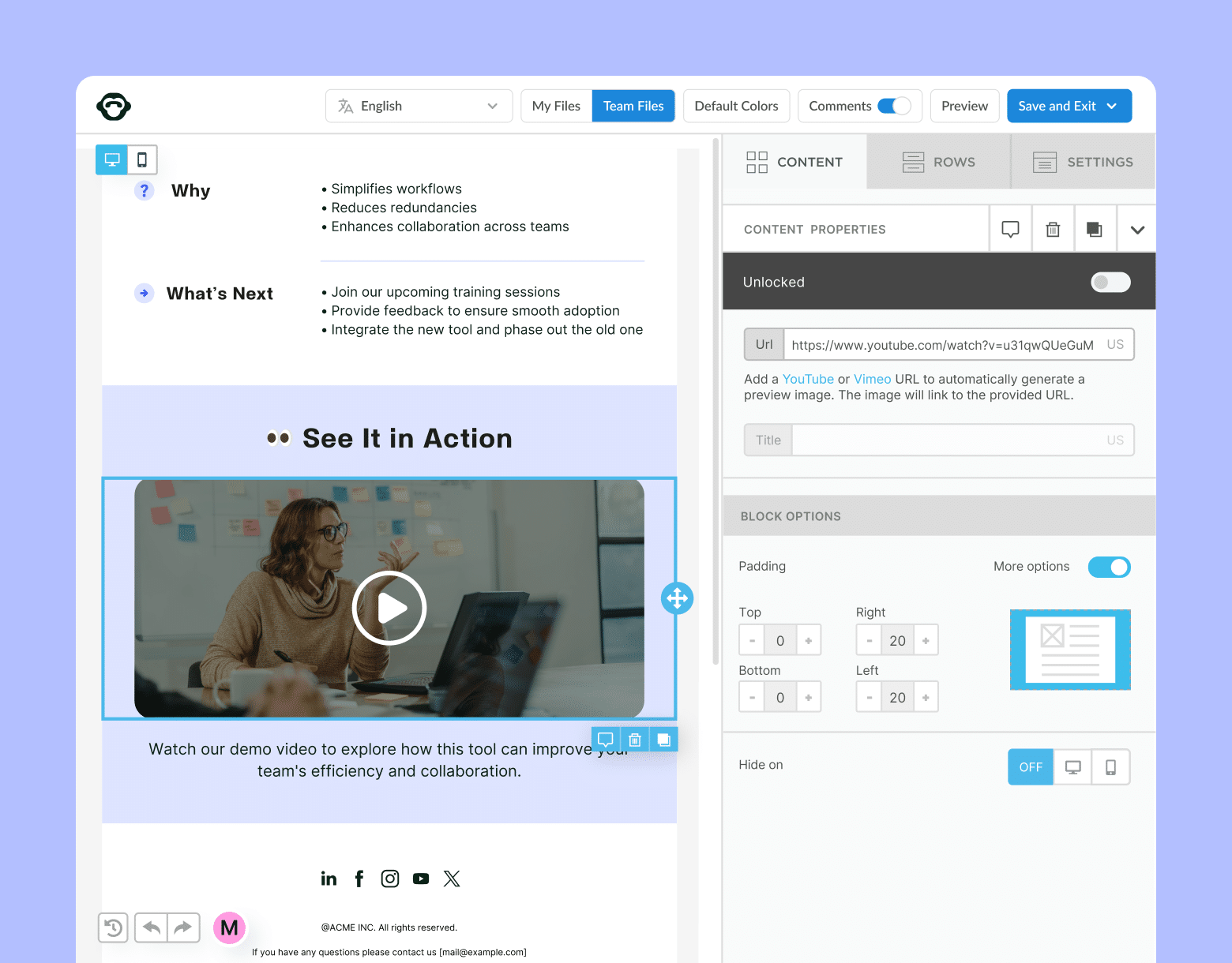
What Are Employee Engagement Analytics?
Employee engagement analytics is the process of collecting and interpreting data to understand how your people really feel about work—what drives them, what slows them down, and what keeps them connected (or not) to your company.
But it’s not just about data points. Employee engagement analytics takes emotional intangibles—like motivation, trust, and belonging—and turns them into measurable signals using tools like surveys, pulse check-ins, feedback forms, and even internal communication data.
Think of it as turning the invisible into the actionable.
See how ContactMonkey’s analytics features make it easy to analyze employee engagement with emails, newsletters, and surveys.
The Importance of Employee Engagement Analytics
Let’s be real—work has changed. Hybrid teams, economic uncertainty, and the rise of AI mean your employees are navigating a very different world than they were just a few years ago. And old engagement playbooks aren’t cutting it.
Employee engagement data analytics helps organizations:
- Understand how engaged their employees really are (not just what they say in meetings).
- Diagnose which parts of the company culture are thriving—or flatlining.
- Tie engagement to real business outcomes like retention, productivity, and innovation.
If you want to build a high-performing workplace in 2025, you need more than happy vibes. You need hard data—and a plan to act on it.
The Benefits of Using Analytics to Improve Employee Engagement
When done right, employee engagement analytics isn’t just about charts and dashboards. It’s about unlocking better decisions and building a workplace where people want to stay, contribute, and grow.
Here’s what you can expect when you get serious about analytics for employee engagement:
- Stronger retention: Analytics for employee engagement can flag early warning signs—so you intervene before top talent walks.
- More informed strategy: With the right employee engagement analytics software, you’ll know what actually works (and what doesn’t).
- Higher productivity: Engaged employees don’t just do more—they do better. Data helps you fine-tune conditions for high performance.
- Smarter investment: Instead of throwing spaghetti at the wall, you’ll invest in engagement initiatives that actually move the needle.
Analytics helps you go from guessing to knowing—and from reacting to proactively building a thriving workforce.
Start two-way conversations and employee feedback loops
Learn how to engage staff with pulse surveys, content ratings and reactions, custom polls, and more. Ready to send modern emails?
See engagement features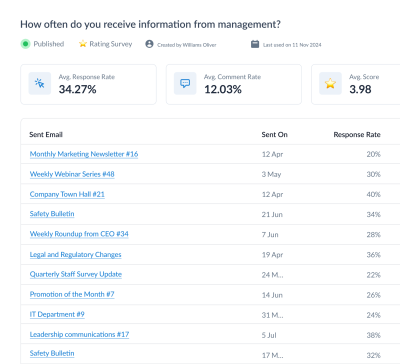
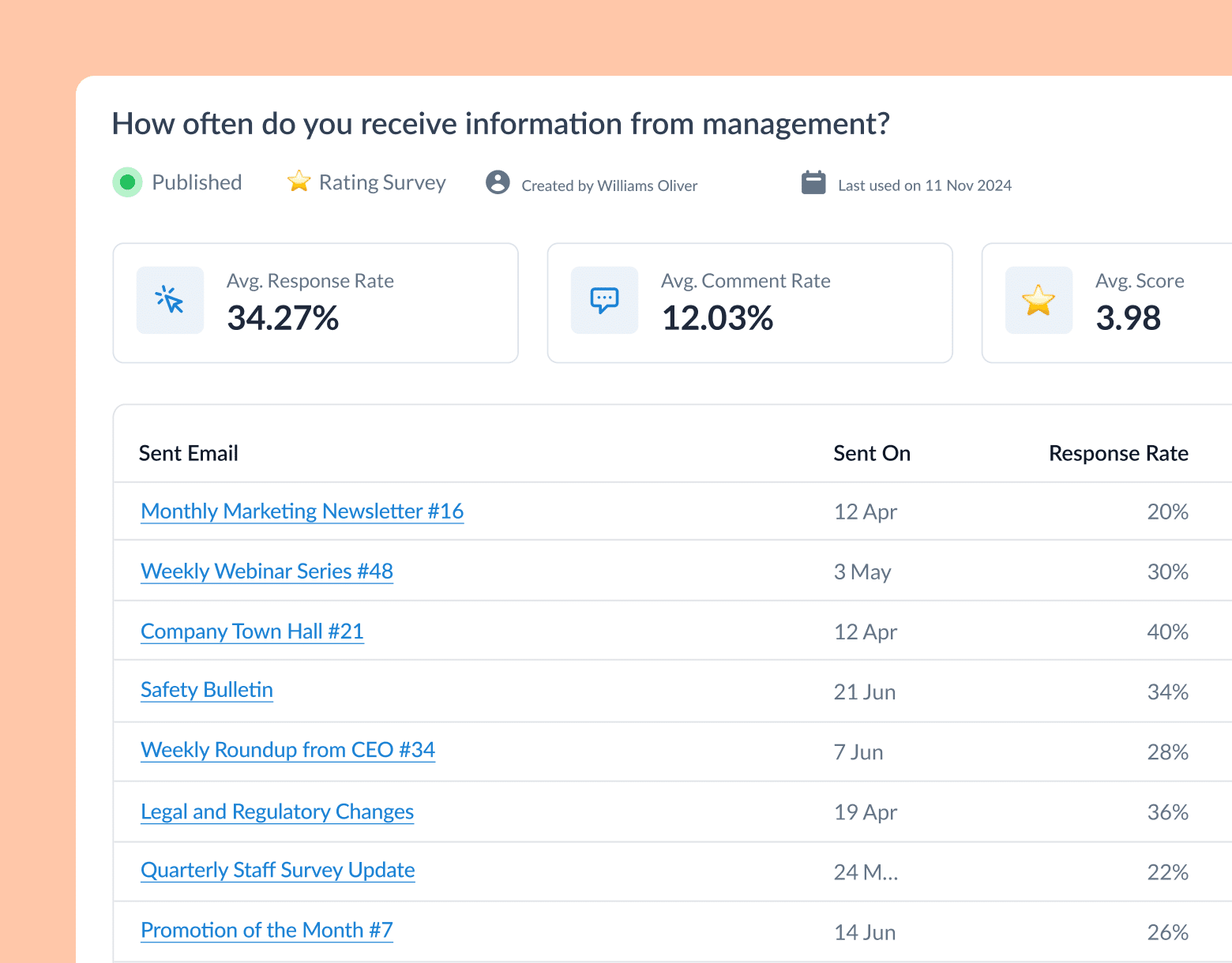
What Employee Engagement Metrics and KPIs Should You Track?
If you want to understand how engaged your team really is, these are the employee engagement metrics and KPIs that matter most.
1. Employee Net Promoter Score (eNPS)
The Employee Net Promoter Score measures how likely employees are to recommend your company as a place to work.
Why this matters: It’s a simple, powerful indicator of loyalty and satisfaction.
Actionable example: Include a single-question eNPS survey in your monthly internal newsletter: “On a scale of 0–10, how likely are you to recommend [Company] as a place to work?” Track changes quarter over quarter, and segment results by department to spot emerging issues.
2. Pulse survey scores
Quick, recurring surveys that track real-time sentiment.
Why this matters: They help spot shifts in morale—before problems escalate.
Actionable example: Send a weekly or biweekly one-question pulse survey using tools like ContactMonkey. Use questions like:
- “How energized do you feel about your work this week?”
- “Do you feel supported by your manager right now?
Use these insights to spot dips during crunch periods or after major company announcements.
3. Turnover and retention rates
Percentage of employees leaving vs. staying.
Why this matters: High churn is often a lagging indicator of low engagement.
Actionable example: Compare turnover data across teams alongside eNPS or pulse scores. If turnover is high in a specific department, conduct exit interviews or anonymous stay interviews to identify patterns and address them early.
4. Participation rates in engagement initiatives
Tracks how many employees actually engage with your programs.
Why this matters: Low participation often signals misalignment or mistrust.
Actionable example: Track attendance at wellness webinars, town halls, or engagement campaigns. If 70% of employees are skipping your internal events, it may be time to reevaluate the timing, format, or relevance of those programs—and collect feedback on how to improve.
5. Manager effectiveness ratings
Usually collected via feedback forms or pulse surveys.
Why this matters: A Gallup study found that managers account for 70% of the variance in engagement. Understanding how effective managers are can help you understand how they are influencing employee engagement.
Actionable example: Run a quarterly anonymous survey asking questions like:
- “Does your manager give you regular feedback that you find helpful?”
- “Do you feel comfortable bringing up concerns with your manager?”
Use these results in manager 1:1 coaching or leadership development efforts.
Bonus: Other employee engagement KPI examples
- % of employees who feel recognized
- % who say they’re growing professionally
- % who feel aligned with company values
Together, these metrics give you a clearer picture of how engaged employees are—and where to focus your efforts.
Get powerful email analytics and reporting features
Know exactly who is opening and engaging with your employee communications and company newsletters.
Explore analytics & reporting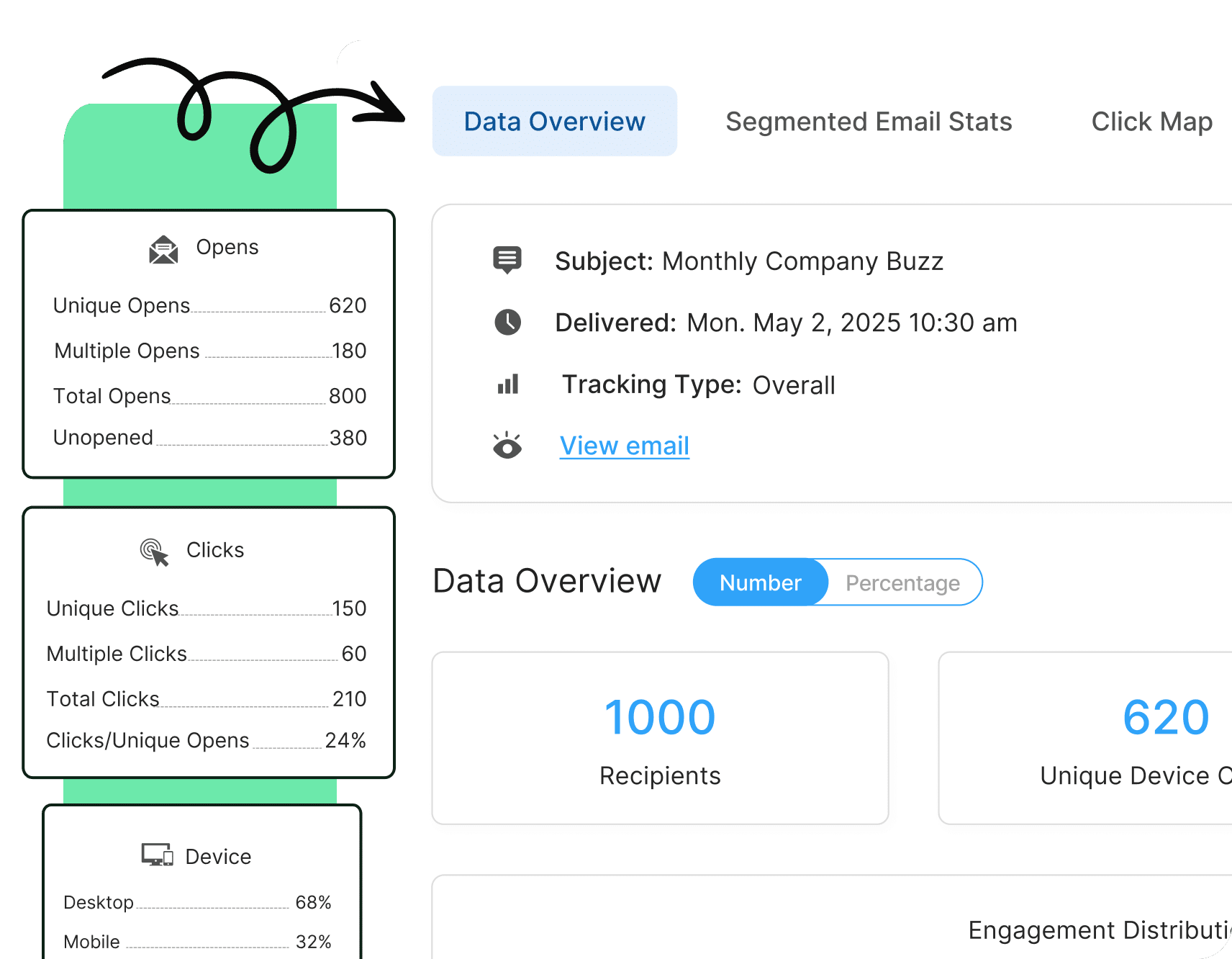
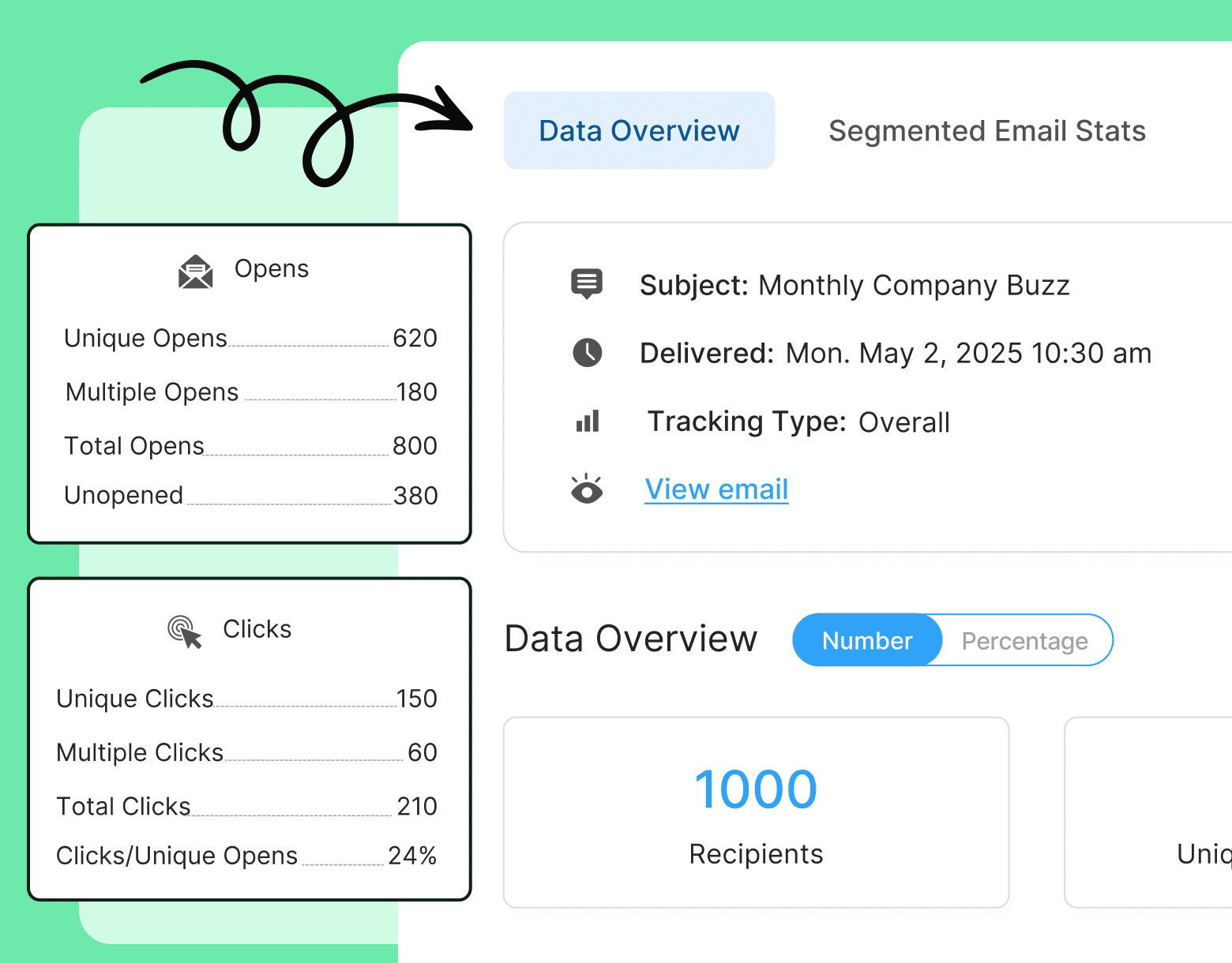
How to Implement an Effective Employee Engagement Analytics Program
Building a successful employee engagement analytics program deals with building a smart, repeatable system that works for your people.
Here’s how to do it:
Step 1: Define your employee engagement analytics program goals
Before diving into the data, you need a clear sense of what success looks like. Setting specific, measurable goals ensures your analytics efforts stay focused and relevant to your business objectives.
Questions to answer:
- What aspects of engagement are we trying to improve (e.g., retention, recognition, culture)?
- What decisions will this data help us make?
- How will we know if our strategy is working?
Tips to execute this step:
- Align your goals with existing business priorities (e.g., reduce turnover in key departments).
- Set benchmarks using previous employee engagement survey analytics or industry averages.
- Choose 2–3 key outcomes to track first—then expand.
Considerations:
- Avoid trying to track everything at once. Prioritize what matters most to your organization now.
- Make sure leadership and HR are aligned on the goals—this helps drive buy-in.
PRO TIP: Tie engagement goals and your employee engagement analytics strategy to tangible business outcomes (like customer satisfaction or revenue per employee) to strengthen your program and business case for internal communications software.
Step 2: Choose the right tools to help you execute
The right employee engagement analytics software will streamline your data collection, segmentation, and reporting processes—so you spend less time wrangling spreadsheets and more time making decisions.
Questions to answer:
- What tools can we use to collect and analyze feedback?
- Do we need integrations with Outlook, Gmail, Slack, or HRIS platforms?
- How much automation and reporting do we want?
Tips to execute this step:
- Look for tools like ContactMonkey that support embedded surveys, sentiment tracking, and real-time analytics.
- Choose platforms that allow you to segment engagement by department, location, or employment type.
- Use software with dashboards to visualize employee engagement metrics clearly.
Considerations:
- Factor in user-friendliness—tools should be intuitive for both admins and employees.
- Make sure your chosen tool is compliant with data privacy standards (e.g., GDPR).
PRO TIP: ContactMonkey’s internal communications software lets you embed pulse surveys directly into your employee emails, segment lists by employee type, and track analytics for employee engagement in real time, thanks to the Analytics Dashboard Feature — no code, no hassle.
Organize your contacts with list management
Save time managing employee lists by syncing everything in one place.
Learn more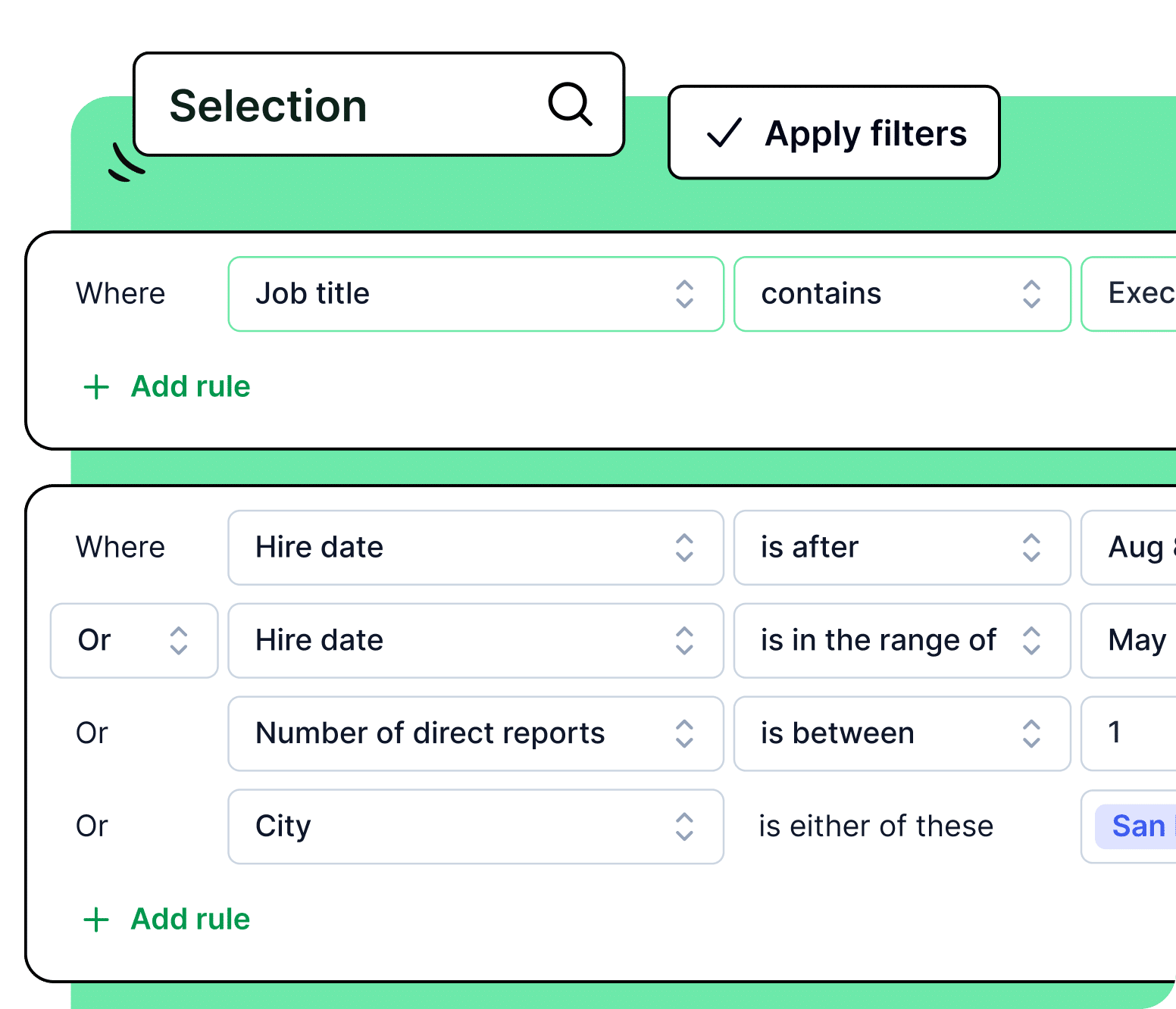
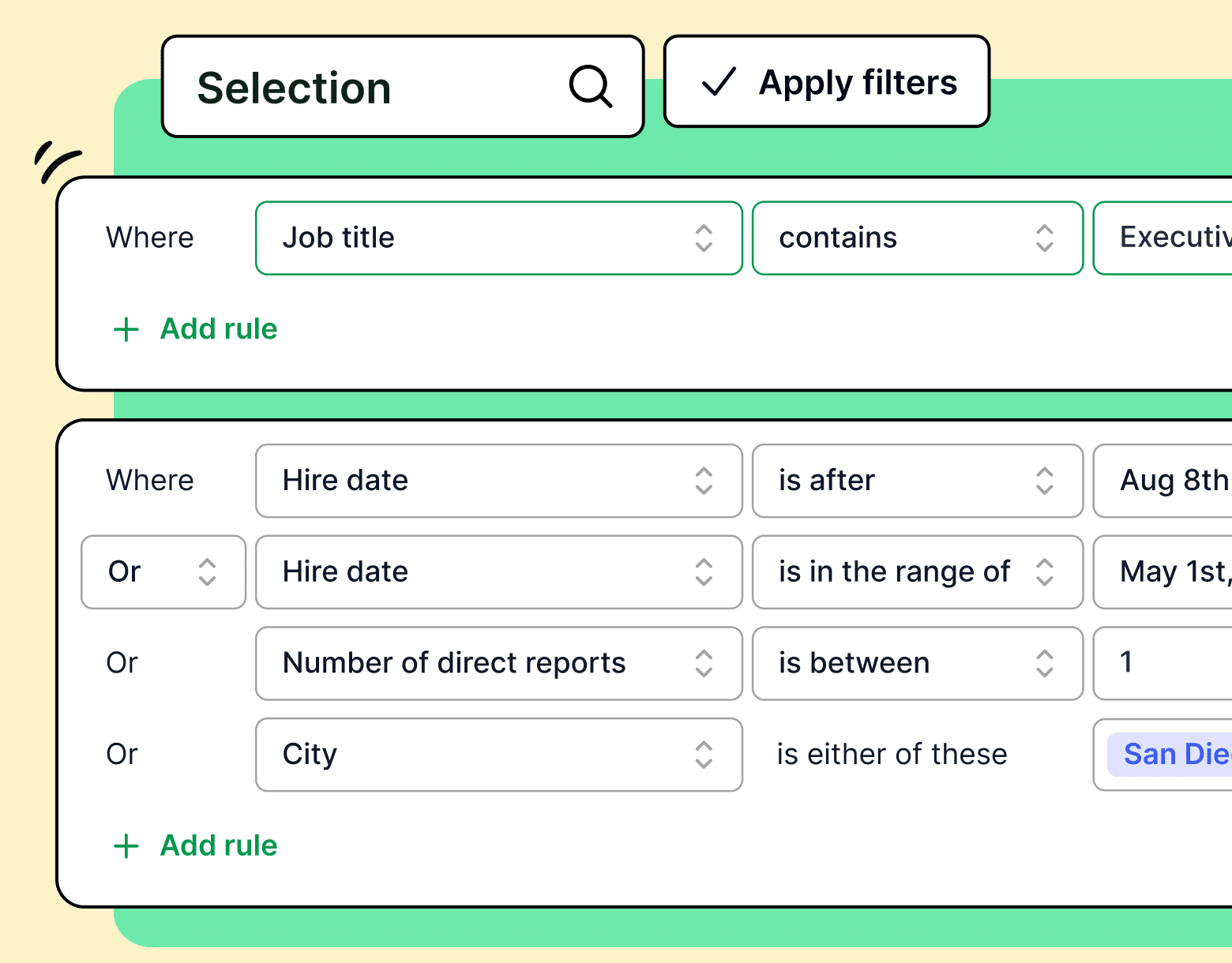
Step 3: Segment your employee lists and personalize content
Not all employees experience work in the same way. Audience segmentation gives you more accurate, actionable insights by team, department, or location.
Questions to answer:
- Which groups should we compare or track separately?
- Are there differences in experience by job type, location, or tenure?
- What level of segmentation can our tools support?
Tips to execute this step:
- Group employees by function, level, or geography.
- Tailor survey questions to reflect relevant experiences for each group.
- Track engagement KPIs and trends by segment over time.
Considerations:
- Over-segmentation can make data noisy. Focus on what’s meaningful.
- Anonymous feedback may be harder to maintain in smaller teams—balance specificity with privacy.
PRO TIP: Use ContactMonkey’s list segmentation to target custom survey questions and content by role, region, or employment type, making your employee engagement analytics more precise and personalized.
Step 4: Collect both quantitative and qualitative data
A complete view of engagement combines what the numbers say with how employees feel. Quantitative data shows patterns; qualitative responses show context.
Questions to answer:
- What hard data can we track? What open feedback should we gather?
- How often should we collect each type of data?
- Are we asking the right questions?
Tips to execute this step:
- Use a mix of eNPS, pulse surveys, satisfaction scores, and open comments.
- Embed surveys in internal emails and newsletters for easier participation.
- Use tools that analyze sentiment and keyword trends in feedback.
Considerations:
- Don’t rely solely on scores—stories behind the numbers often reveal deeper issues.
- Make sure open feedback is truly anonymous if you want honesty.
BONUS: Learn how to use surveys in internal emails with our insightful guide! This will tell you about different employee surveys available and the best methods to engage employees with email surveys.
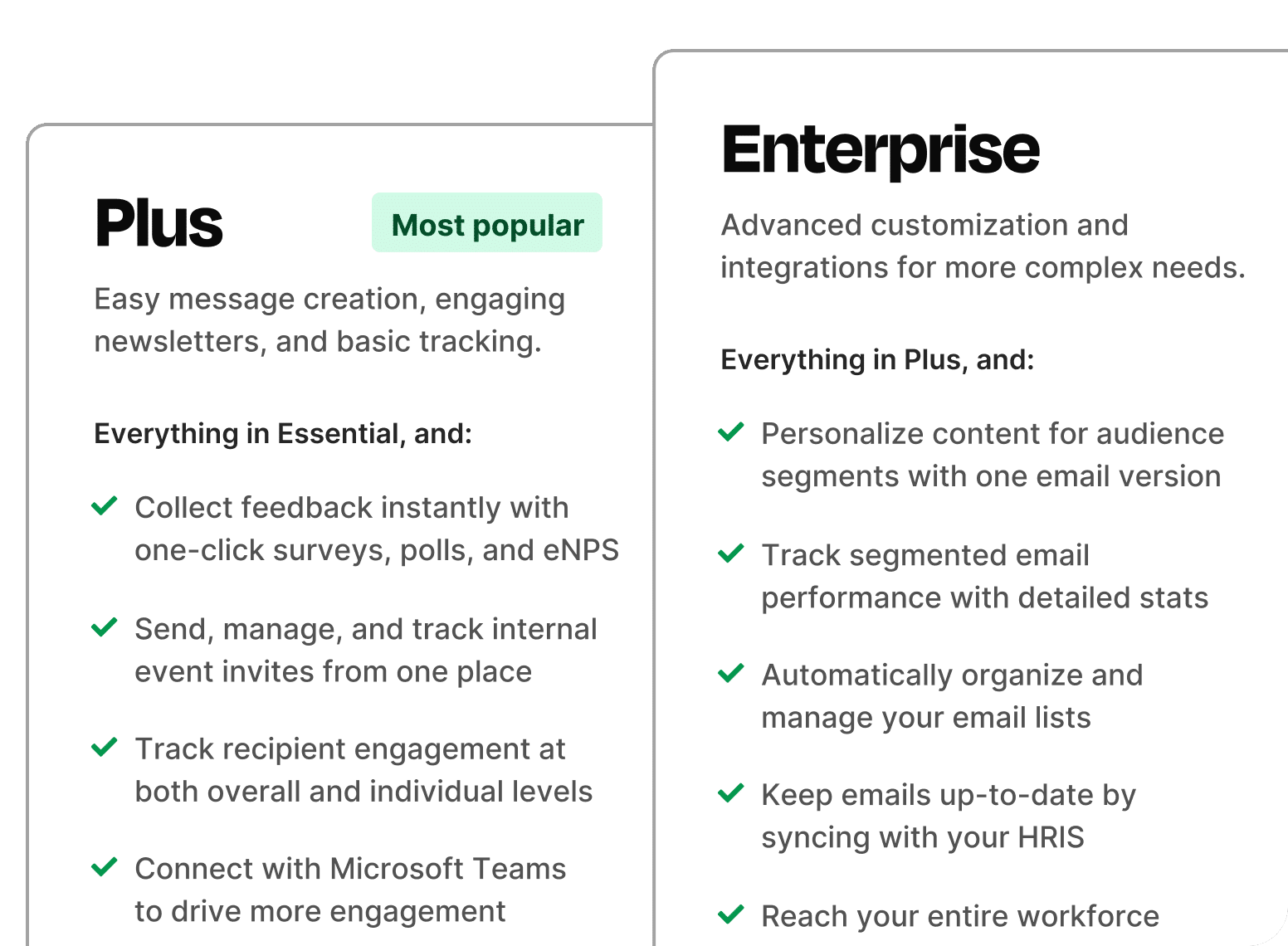
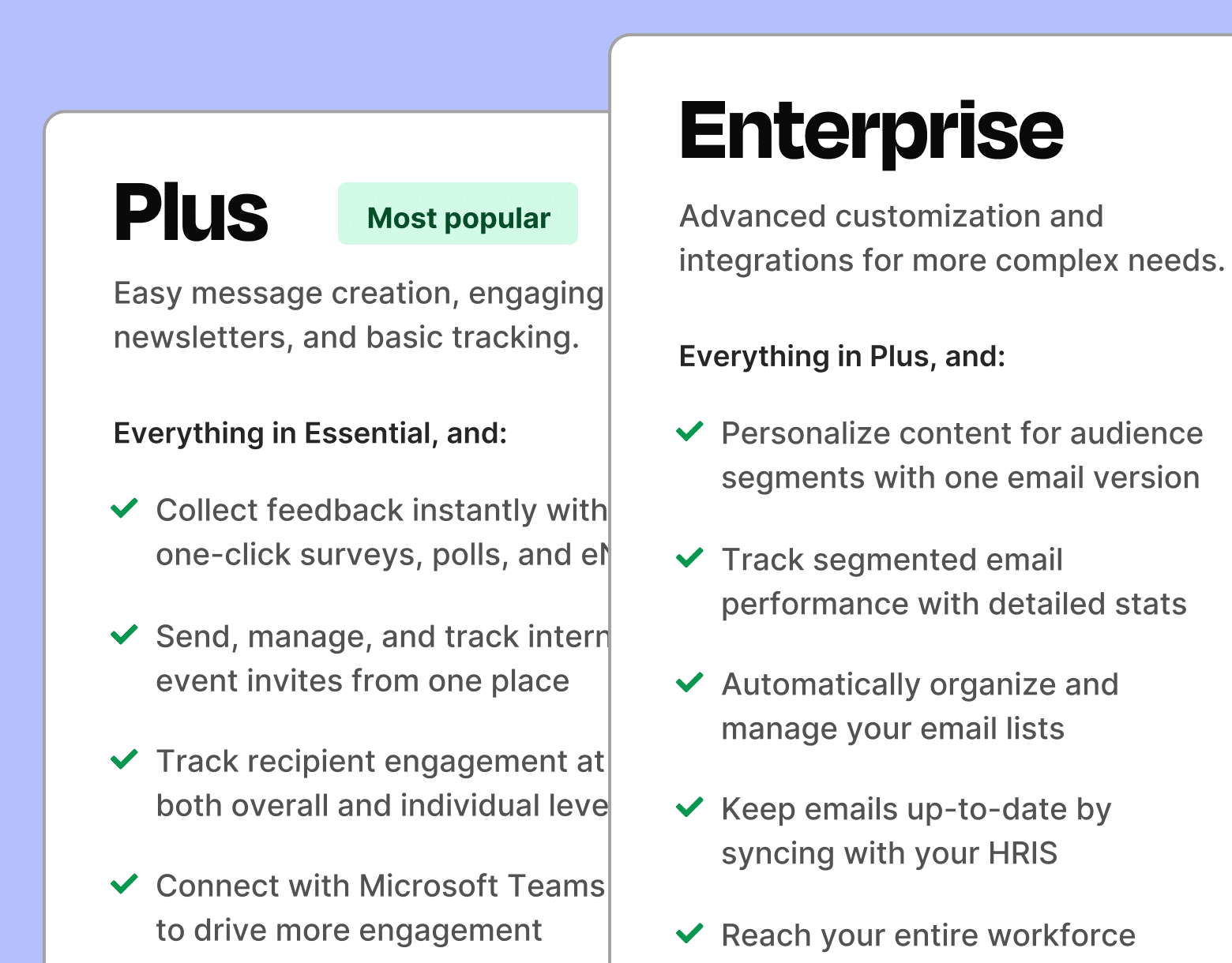
Step 5: Analyze your data with intention
Data is only useful if you understand what it’s telling you. After you measure employee engagement, focus on trends over time, red flags by team, and correlations between engagement and performance.
Questions to answer:
- What patterns are emerging over time?
- Are any teams or departments struggling more than others?
- What external events (layoffs, policy changes, reorgs) may be affecting engagement?
Tips to execute this step:
- Set a regular cadence (monthly or quarterly) for reviewing your data.
- Use dashboards to visualize engagement dips and spikes.
- Look for links between survey results and metrics like absenteeism or turnover.
Considerations:
- Watch out for confirmation bias—don’t cherry-pick results that support your assumptions.
- Context matters: compare results against past data and employee engagement benchmarks.
PRO TIP: Analytics for employee engagement can help you forecast future attrition risks or burnout trends—so you act before the damage is done.
Step 6: Turn insights into action for your employee engagement analytics program
Insight without action is just information. Close the employee feedback loop by addressing feedback, improving engagement, and tracking what changes.
Questions to answer:
- What did we learn—and what should we do about it?
- Which teams or issues need the most attention?
- How will we communicate what we’re doing back to employees?
Tips to execute this step:
- Create an action plan tied to each major insight.
- Assign ownership and timelines for follow-up.
- Share what you’re doing in response to feedback—transparency builds trust.
Considerations:
- Don’t over-promise. Focus on realistic, high-impact changes.
- Avoid “survey fatigue” by showing that feedback leads to action.
PRO TIP: Use performance dashboards to show leadership how employee engagement improvements are impacting employee engagement KPIs—turning your analytics into advocacy for more resources.
Watch ContactMonkey LIVE in action
Join live demo
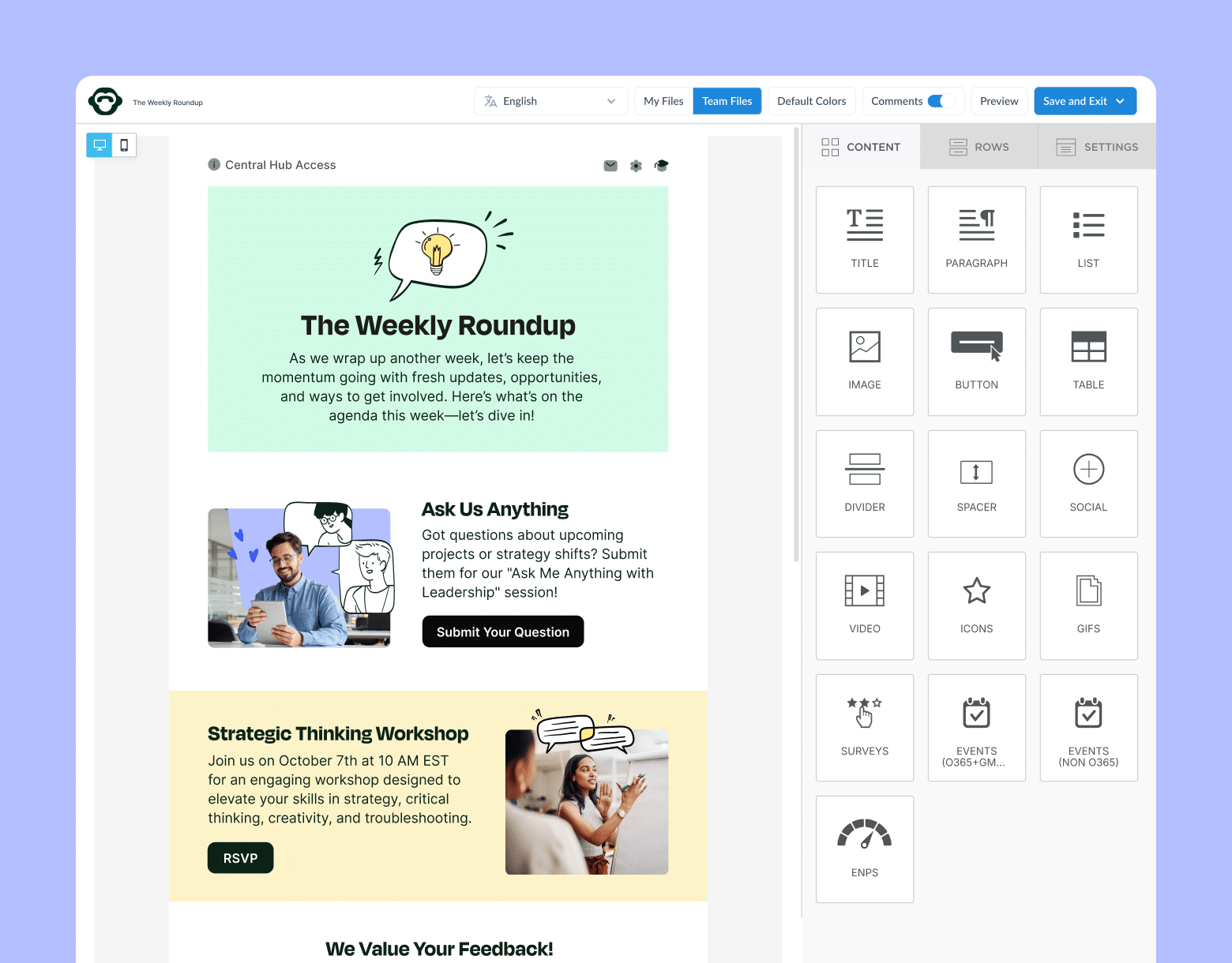
How ContactMonkey Stands Out as an Employee Engagement Analytics Platform
While there are plenty of tools that promise to improve engagement, ContactMonkey was built specifically for internal communicators.
Here’s what makes ContactMonkey different when it comes to employee engagement analytics:
Embedded, two-way communication—all inside Outlook or Gmail
- Embed surveys, star ratings, pulse checks, and anonymous feedback forms directly into internal emails with Employee Feedback Features.
- Increase participation through two-way communication without disrupting workflows through Outlook and Gmail integrations.
- Drive stronger employee engagement survey analytics instantly.
Real-time analytics and visual dashboards
- Track opens, clicks, survey responses, and sentiment in real time.
- Filter data by department, location, or employment type.
- Make analytics for employee engagement instantly actionable—no spreadsheets required.
Precise audience targeting
- Use the List Management Feature to segment by role, location, or employment type.
- Deliver the right message and survey to the right employees.
- Avoid survey fatigue and enhance the accuracy of your employee engagement data analytics.
Predictive trends and performance tracking
- Spot engagement dips—like rising burnout, falling eNPS, or newsletter drop-off—before they become bigger issues.
- Use employee engagement analytics to forecast risks and take timely action.
- Measure and validate the impact of your initiatives with data-backed confidence.
Built for internal comms teams
- Designed specifically for communicators—not retrofitted from HR tools.
- Get faster access to insights without relying on IT or analytics teams.
- Work with tools that align with your internal comms workflow, from email to feedback to reporting.
If you’re ready to stop guessing and start knowing what really drives your employees, ContactMonkey makes it easy to collect, analyze, and act on employee engagement data. Book a free 15-minute call with one of our experts and see how you can turn feedback into forward motion—starting today!

